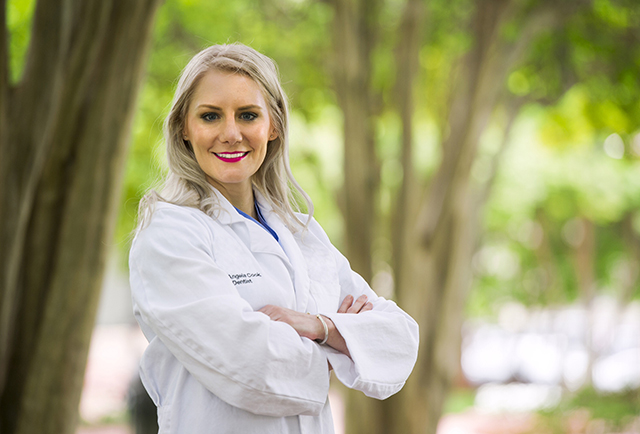Orofacial clefts and quality of life

Pediatric dentistry resident’s award-winning research sheds light on ways to improve some young patients’ experiences at the dentist
Just a few weeks into her pediatric dentistry residency at Texas A&M University Baylor College of Dentistry, Dr. Angela Cook noticed a concerning pattern. Her patients with orofacial clefts appeared more hesitant to receive treatment than their peers.
“They were a lot more anxious, more timid,” says Cook. She offers an explanation for why children with cleft lip and/or cleft palate — a malformation in which the tissues of the lip or palate fail to fuse in the embryo, creating an opening in the upper lip or the roof of the mouth — may feel this way. “They’ve had a history of procedures around their mouths, so that makes them a lot more sensitive to invasive dental treatment,” Cook says. “I had to learn how to approach them in a manner that made them feel comfortable and safe, even though they have had surgeries throughout their lives.”

Those patient care experiences formed the foundation of her master’s thesis,“Quality of Life Associations with Caries and Behavior in the Dental Setting Among Children with Orofacial Clefts,” which assesses quality-of-life issues — specifically the correlation between psychological and dental conditions. To do this, Cook gathered input from 4- to- 10-year-old orofacial cleft patients and their parents, comparing it with demographics, surgical history, behavior and dental clinic records. The results demonstrate a significant connection among negative behavior in the dental chair, reduced health-related quality of life and increased incidence of cavities and decay.
The findings are garnering national attention. On April 22, Cook presented her research during the American Cleft Palate-Craniofacial Association annual meeting as a recipient of the 2015 Mary J. Hauk, DDS, MPH Memorial Scholarship for Dental Residents. Come May, she will share the same findings with attendees of the American Academy of Pediatric Dentistry Annual Session in Seattle, where she also will be recognized as a winner of the Graduate Student Research Award.
As part of the TAMBCD residency, Cook rotates to pediatric dentistry clinics affiliated with Dallas hospitals. The college’s partnership with Children’s Health of Dallas means residents have exposure to the hospital’s Pediatric Plastic and Craniofacial Surgery team, a multidisciplinary group dedicated to treating patients with conditions such as orofacial cleft.

It’s how Cook met Dr. Celia Heppner, a pediatric psychologist on the craniofacial team at Children’s and assistant professor at UT Southwestern Medical Center, who with Dr. Carolyn Kerins, pediatric dentistry graduate program director at TAMBCD, has worked as a mentor on Cook’s thesis.
“Angela’s project is calling attention to what providers may see clinically and behaviorally during dental visits and what might actually be going on in a broader, quality-of-life sense,” says Heppner. “Making those connections will help contribute to the way that dentists make referrals and address some of these issues.” It’s crucial, Heppner says, as dentists are one of the key health care providers for patients with orofacial clefts.
Cook, who will graduate in June, applies her findings each day in the clinic.
“My main interest is to optimize these patients’ experiences at the dentist,” says Cook. “For me, researching their experiences has helped me be more sensitive to the way I treat them.”